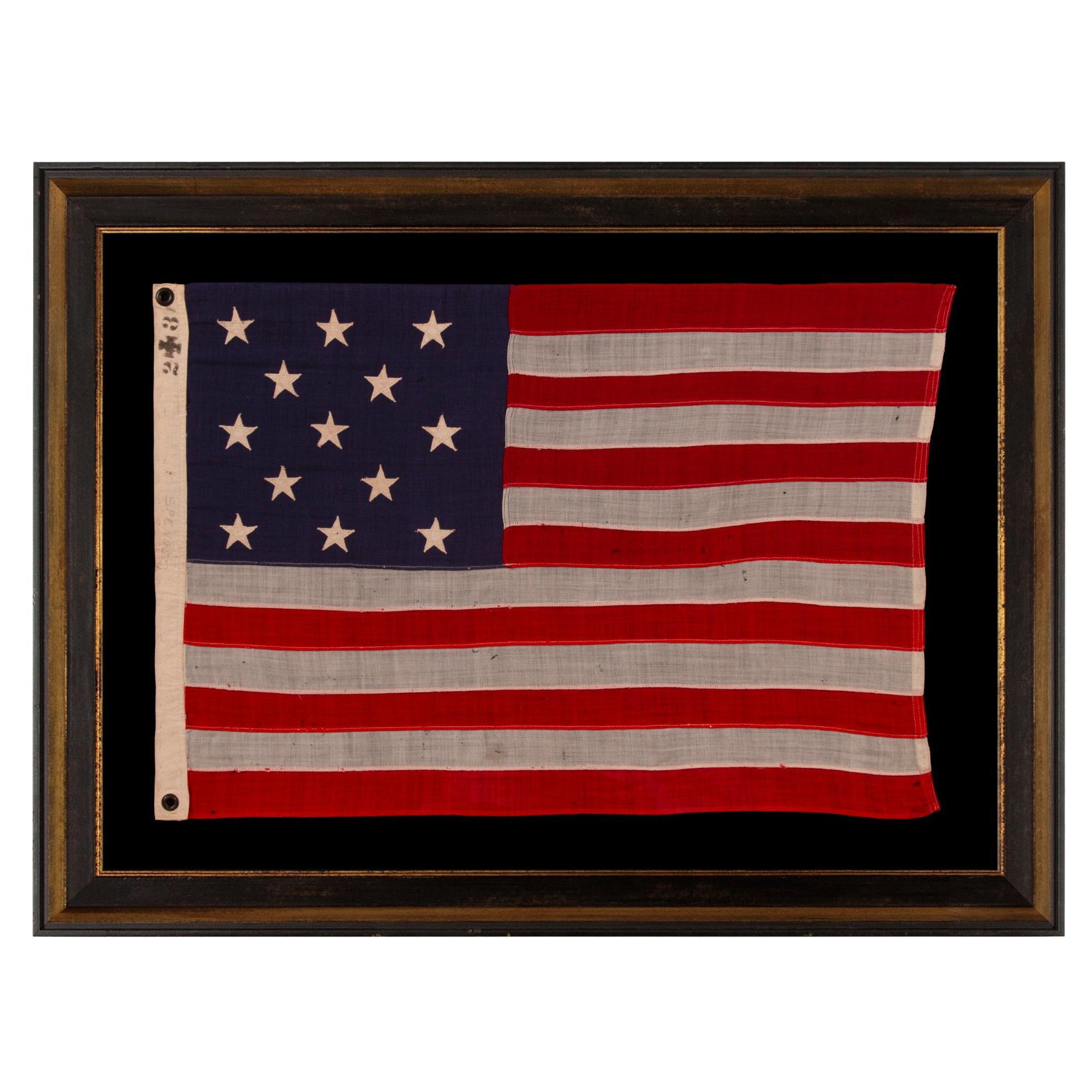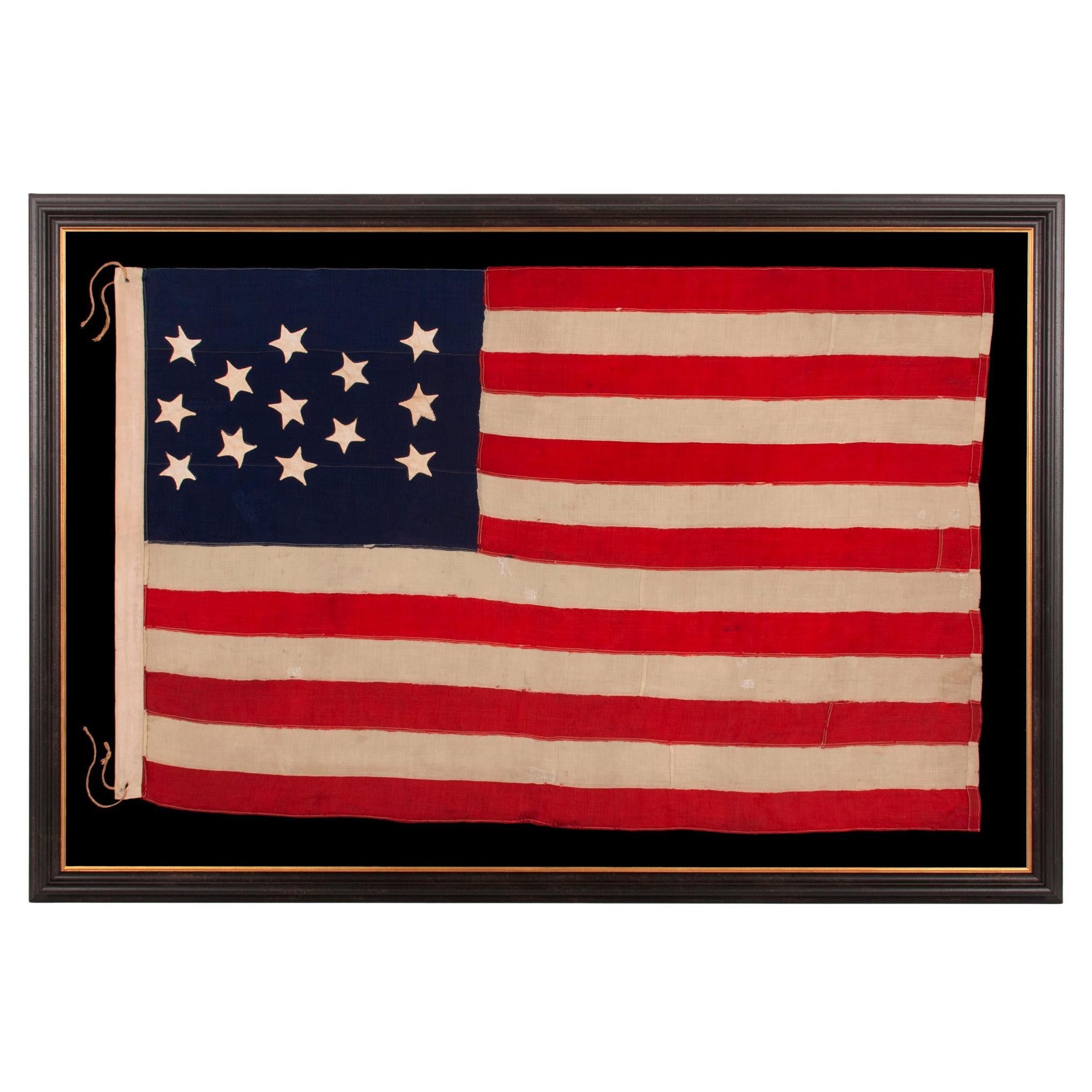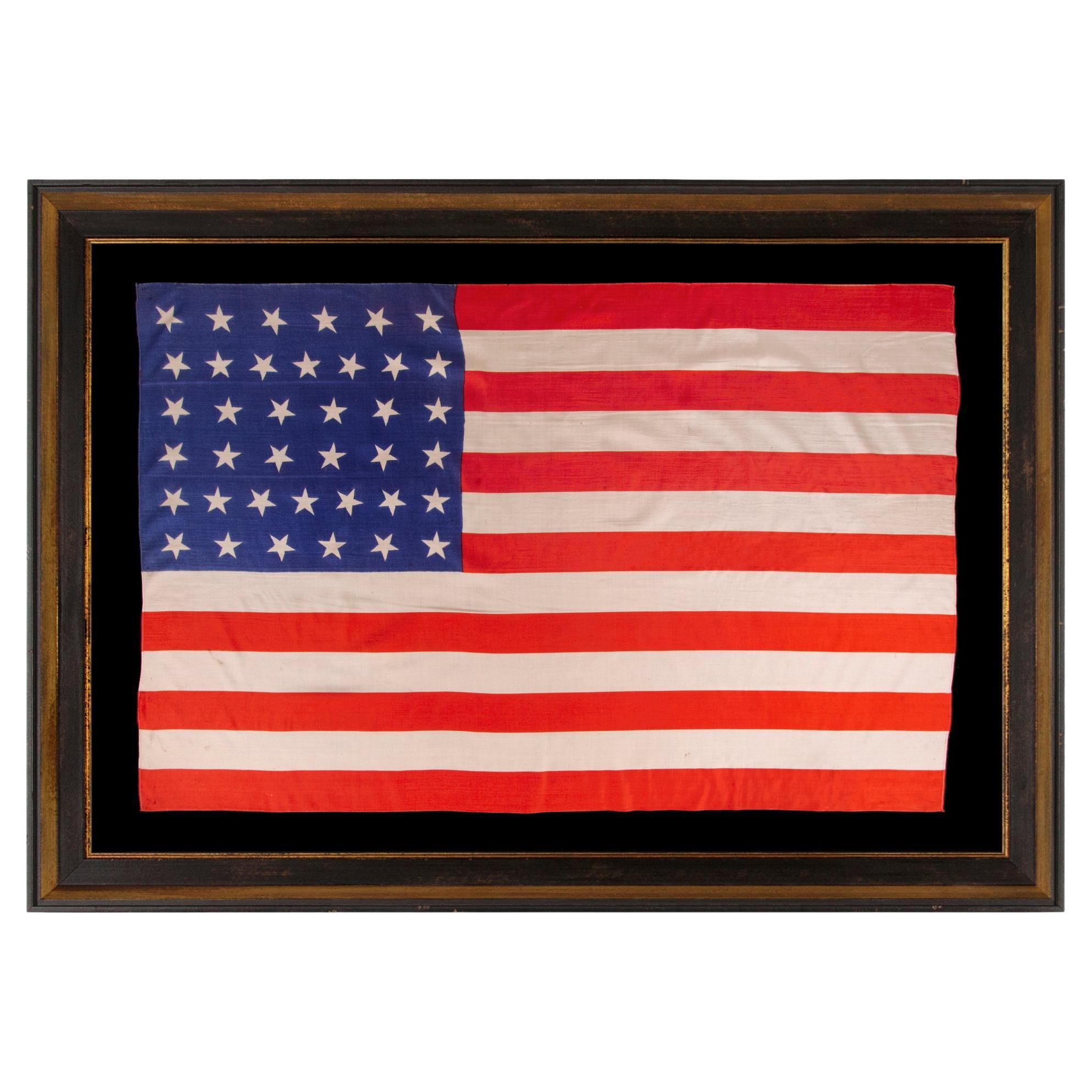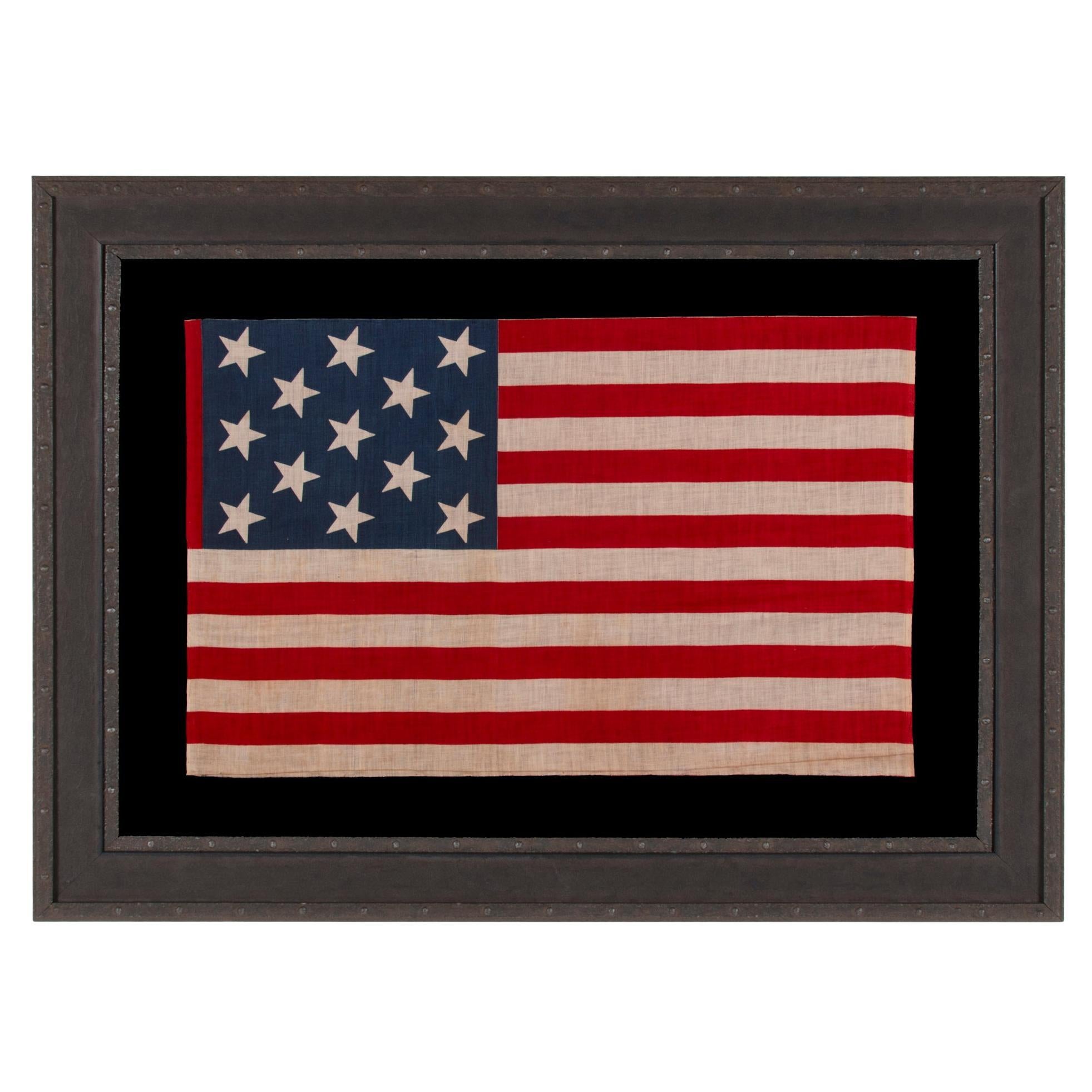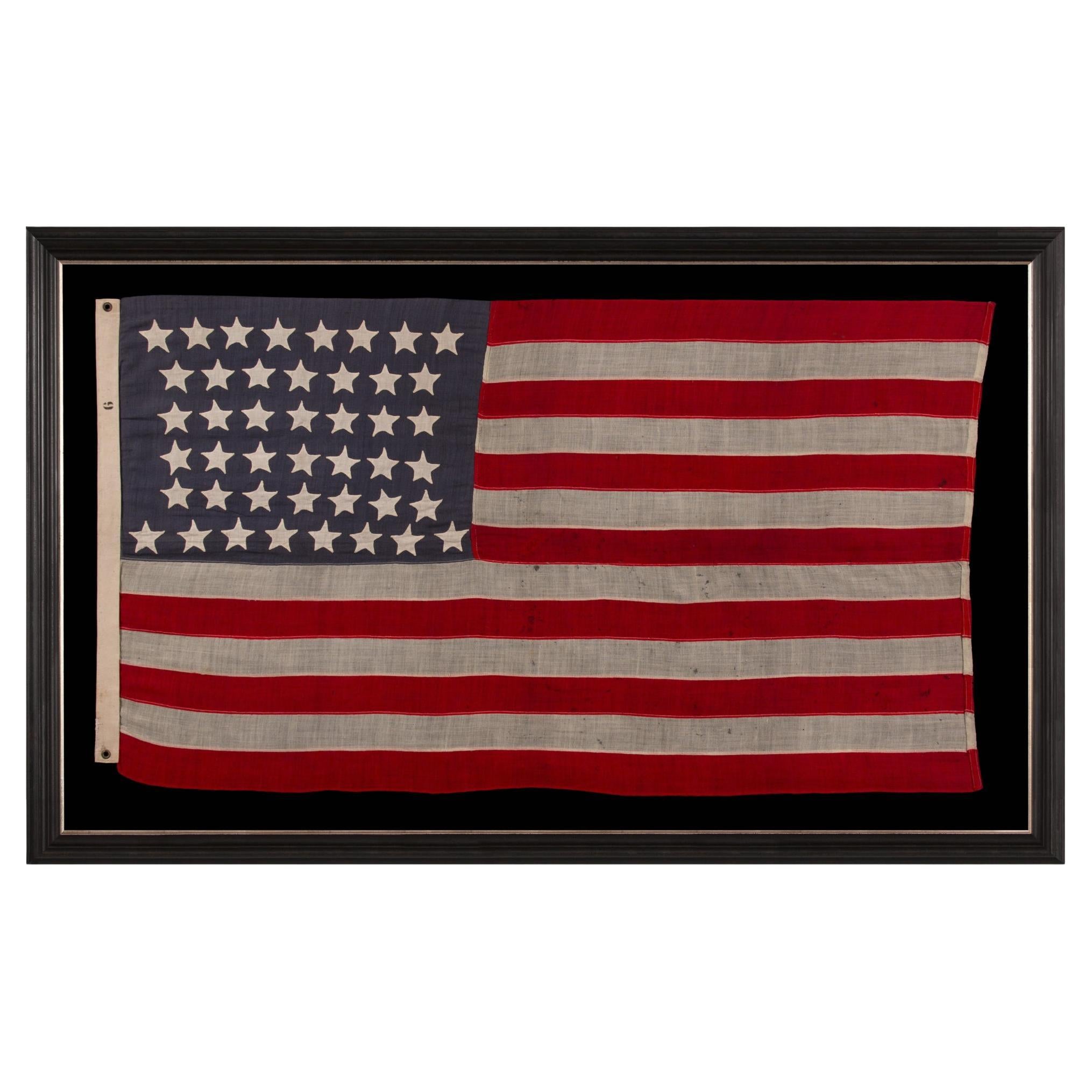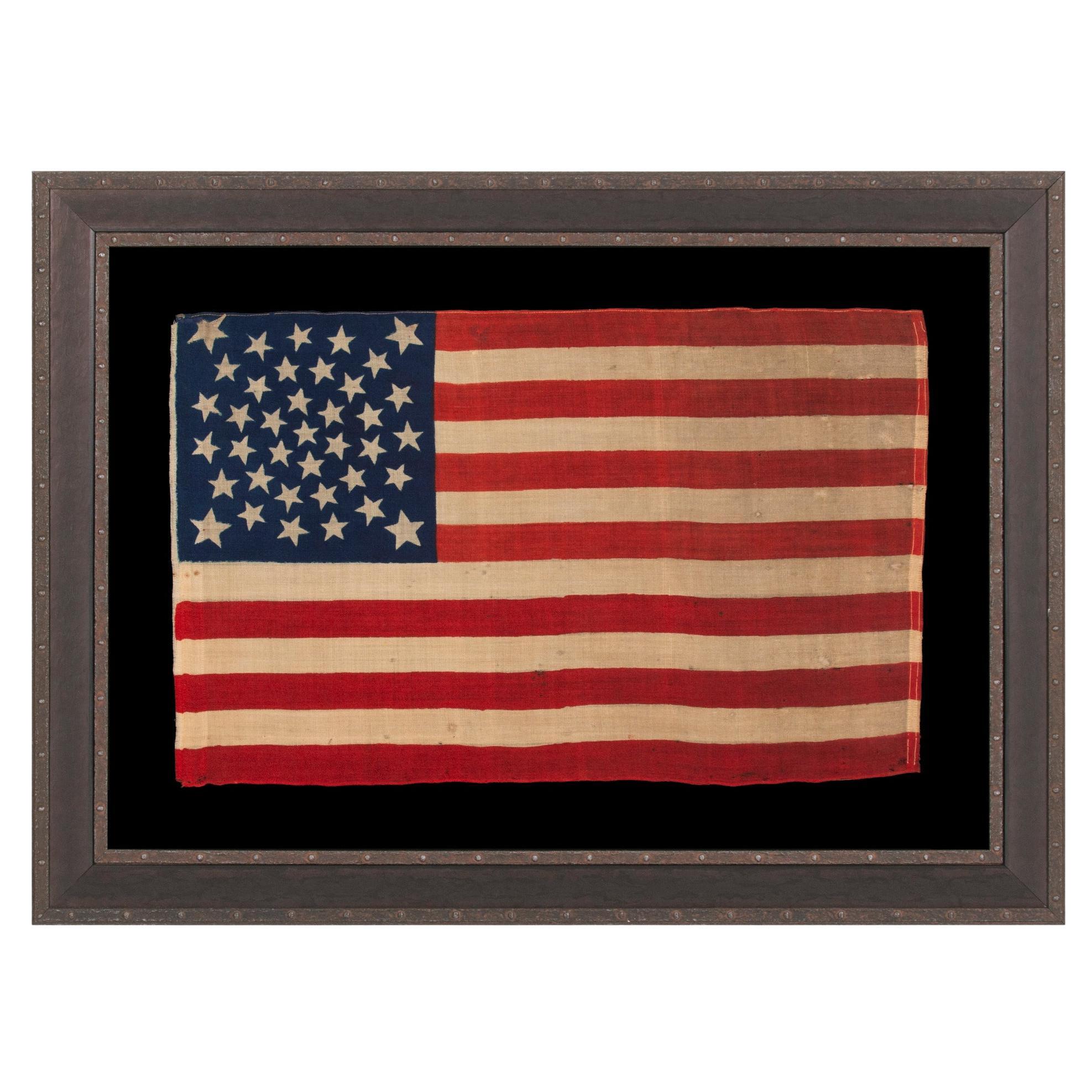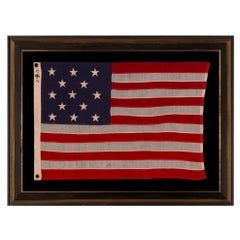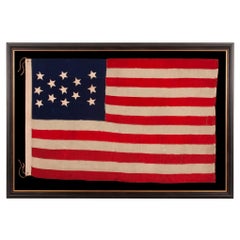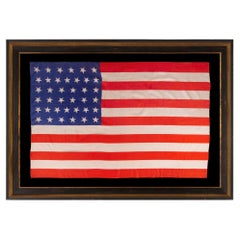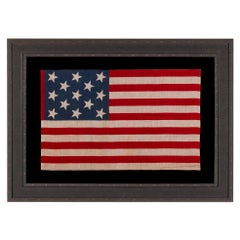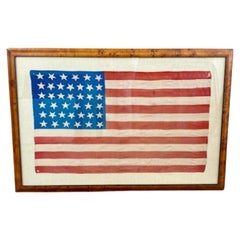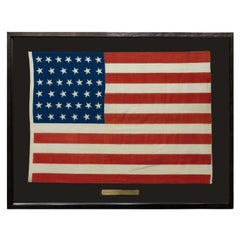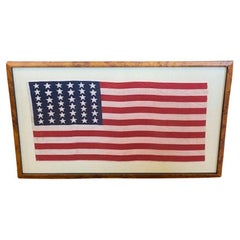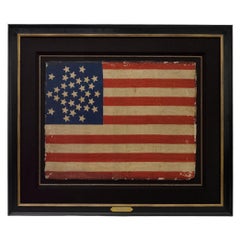Articoli simili a Bandiera americana antica a 13 stelle, marcata "R.H Macy's & Co", circa 1895-1926
Vuoi altre immagini o video?
Richiedi altre immagini o video al venditore
1 di 7
Bandiera americana antica a 13 stelle, marcata "R.H Macy's & Co", circa 1895-1926
Prezzo su richiesta
Spedizione
Recupero del preventivo…La promessa 1stDibs:
Garanzia di autenticità,
Garanzia di rimborso,
Annullamento entro 24 ore
Informazioni sull’articolo
13 STAR ANTIQUE AMERICAN FLAG WITH A 3-2-3-2-3 CONFIGURATION OF STARS; A SMALL-SCALE EXAMPLE, MADE IN THE 1895-1926 ERA, MARKED “R.H. MACY & CO.”
13 star antique American flag of the small-scale type made during the last decade of the 19th century through the beginning of the 20th. The canton and stripes are made of wool bunting that has been pieced with lineal, machine stitching. The stars are made of cotton and are double-appliquéd (applied to both sides) with a zigzag machine stitch. These are arranged in staggered rows of 3-2-3-2-3. There is a narrow, twill cotton binding along the hoist, folded over at the top and bottom for added strength, prior to installation, with two white metal grommets.
Because there was no official star design for the American flag until 1912, the star pattern was left to the whims of the maker. The 3-2-3-2-3 design became the most often seen 13 star configuration during the latter 19th century and remained so throughout the first quarter of the 20th. In most cases this can also be viewed as a diamond of stars, with a star in each corner and a star in the very center. It is likewise of interest to note that it can also be interpreted as a combination of the crosses of St. Andrew and St. George, which may reflect a link between this arrangement and the British Union Jack.
The 3-2-3-2-3 pattern is often attributed--erroneously in my opinion--to New Jersey Senator Francis Hopkinson, a member of the Second Continental Congress and of the Marine Committee, and signer of the Declaration of Independence, who is generally credited with having played the most significant role in the design of the American national flag prior to its June 14th, 1777 adoption. As an amateur artist and an enthusiast in heraldry, Hopkinson designed various official colonial American devices, including the Great Seal of the Treasury and various pieces of colonial currency. He also submitted designs for the Great Seal of the United States. Although Hopkinson’s original sketches for the American flag do not survive, his depictions of 13 star arrangements on other devices do not reflect the 3-2-3-2-3 configuration falsely attributed to him. This seems to have developed from someone’s unsuccessful attempt to make sense of the designs he presented on both drafts submitted to Congress for the Great Seal, which were decidedly random and most certainly intentional in this regard.
The canton and stripes of the flag are made of wool bunting that has been pieced with machine stitching. The stars are made of cotton and double-appliquéd (applied to both sides of the flag) with a zigzag machine stitch. There is a twill cotton binding along the hoist, with two brass grommets, along which “2X3” appears in a faded, red-inked stencil, and the same is hand-inscribed in pencil, to indicate size in feet.
The name “R.H. MACY & CO.” is boldly stenciled in black, near the top of the hoist, likely to indicate ownership. This flag would likely have been displayed by Macy’s department store as decoration, possibly for the opening of its Herald Square location in 1902, or in the patriotism of WWI (U.S. involvement 1917-18), or perhaps to celebrate the 150th anniversary of American independence in 1926. Although Macy’s is likely to have also sold flags, the fact that I have seen just two others with this mark may suggest more limited use.
Why 13 Stars? As the number of stars grew with the addition of new states, it became more and more difficult to fit their full complement on a small flag. The stars would, by necessity, have to become smaller, which made it more and more difficult to view them from a distance as individual objects. The fear was that too many stars would become one white mass and distort the ability to identify American ships on the open seas.
The U.S. Navy used 13 stars on its small-scale flags for precisely this reason. This was, of course, the original number of stars on the first American national flag, by way of the First Flag Act of 1777, and equal to the number of original colonies that became states.
For all practical purposes, commercial flag-makers simply didn't produce flags with pieced-and-sewn construction that were 3 to 4 feet in length before the 1890's. There are exceptions to this rule, but until this time, the smallest sewn flags were generally around 6 feet on the fly. Lengths of 8 feet long and larger were common. Their primary use long having been more utilitarian than decorative, to serve well as signals, flags needed to be large to be effective. Pre-1890, even those sewn flags made for general patriotic display were typically way larger than their modern counterparts. While most early use of flags with sewn construction was to mark ships and government buildings, eventually spreading to local militia and to formal U.S. & state military companies, private use grew with the passage of time, raising the need for long-term use flags of a more manageable scale.
Beginning around 1890, commercial flag-makers began to produce small flags for the first time in large quantities, namely with dimensions of 2 x 3 feet, like this example, or 2.5 x 4 feet. Applying the same logic as the U.S. Navy, they chose the 13 star count rather than the full complement of stars for sake of ease and visibility. Because any flag that has previously been official remains so according to the flag acts of Congress, all 13 star, 13 stripe flags remain official national flags of the United States of America.
The 13 star count has been used throughout our nation's history for a variety of purposes. In addition to being flown by the Navy, 13 star flags were hoisted at patriotic events, including Lafayette’s visit in 1824-25, the celebration of the nation's centennial in 1876, and the sesquicentennial in 1926, as well as for annual celebrations of Independence Day. They were displayed during the Civil War, to reference past struggles for American liberty, and were used by 19th century politicians in political campaigning. The use of yachting ensigns with a wreath of 13 stars surrounding a fouled anchor, which allowed pleasure boats to bypass customs between 1848 and 1980, persists today without an official purpose.
Brief History of R.H. Macy & Co.
“Rowland Hussey Macy opened four retail dry goods stores between 1843 and 1855. One of them was the original Macy's store in downtown Haverhill, Massachusetts; it opened in 1851 to serve the mill industry employees of the area. They all failed, but he learned from his mistakes. Macy moved to New York City in 1858, to establish a new store named "R. H. Macy & Co." on Sixth Avenue between 13th and 14th Streets. The location was far north of where other dry goods stores were at the time…
“As the business grew, Macy's expanded into neighboring buildings, opening more and more departments. The store used publicity devices such as a store Santa Claus, themed exhibits, and illuminated window displays to draw in customers…
In 1875, Macy took on two partners, Robert M. Valentine (1850–1879), a nephew; and Abiel T. La Forge (1842–1878) of Wisconsin, who was the husband of a cousin. Macy died in 1877 from inflammatory kidney disease (then known as Bright's disease).[15] La Forge died the following year, and Valentine died in 1879. Ownership of the company remained in the Macy family until 1895, when the Straus brothers acquired the company. Isidor Straus and his brother Nathan Straus had previously held a license to sell china and other goods in the Macy's store.
In 1902, the flagship store moved uptown to Herald Square at 34th Street and Broadway, so far north of the other main dry goods emporia that it had to offer a steam wagonette to transport customers from 14th Street to 34th Street. Although the Herald Square store initially consisted of just one building, it expanded through new construction, eventually occupying almost the entire block bounded by Seventh Avenue on the west, Broadway on the east, 34th Street on the south and 35th Street on the north… In 1912, Isidor Straus died in the sinking of the Titanic at the age of 67 with his wife, Ida…
The original Broadway store was designed by architects De Lemos & Cordes, was built in 1901–02 by the Fuller Company and has a Palladian facade, but has been updated in many details. There were further additions to the west in 1924 and 1928…designed by architect Robert D. Kohn.” [Source: Wikipedia]
Macy’s Herald Square location was the biggest retail store in the world. It retained this title until 2009, when it was surpassed by Shinsegae Centum City Department Store in Busan, South Korea.
Mounting: For 25 years we have maintained our own textile conservation department, led by a master’s degree level graduate from one of the nation’s top university programs. We take great care in the mounting and preservation of flags and related textiles and have preserved thousands of examples.
The flag has been hand-stitched to 100% silk organza for support throughout. It was then hand-stitched to a background of 100% cotton twill, black in color, that was washed and treated for colorfastness. The black-painted and gilded molding, with its wide, serpentine profile, is Italian. The glazing is U.V. protective acrylic (Plexiglas). Feel free to inquire for more details.
Condition: There is a small hole adjacent to the fly end of the 3rd red stripe, accompanied by tiny holes in the 4th, 5th, and 6th red stripes, and a couple along the lower edge of the last. There is extremely minor soiling along the hoist binding and in the stars. The overall condition is exceptional among wool flags of the period.
- Dimensioni:Altezza: 88,9 cm (35 in)Larghezza: 124,46 cm (49 in)Profondità: 6,35 cm (2,5 in)
- Materiali e tecniche:
- Luogo di origine:
- Periodo:
- Data di produzione:1895-1926
- Condizioni:See Item Description.
- Località del venditore:York County, PA
- Numero di riferimento:Venditore: 13j-17171stDibs: LU849743948312
Informazioni sul venditore
5,0
Venditore riconosciuto
Questi venditori prestigiosi sono leader del settore e rappresentano il massimo in termini di qualità e design.
Fondazione nel 1991
Venditore 1stDibs dal 2008
70 vendite su 1stDibs
Tempo di risposta standard: Da 1 a 2 giorni
- SpedizioneRecupero del preventivo…Spedizione da: York County, PA
- Politica di reso
Alcune parti di questa pagina sono state tradotte automaticamente. 1stDibs non può garantire che le traduzioni siano corrette. L’inglese è la lingua predefinita del sito.
Garanzia di autenticità
Nell’improbabile caso in cui si verifichi un problema con l’autenticità di un articolo, contattaci entro un anno per ottenere un rimborso completo. DettagliGaranzia di rimborso
Se il tuo articolo non corrisponde alla descrizione, è danneggiato durante il trasporto o non arriva, contattaci entro 7 giorni per un rimborso completo. DettagliAnnullamento entro 24 ore
Hai un periodo di tolleranza di 24 ore per annullare il tuo acquisto, senza necessità di fornire spiegazioni.Venditori professionali selezionati
I nostri venditori di livello internazionale devono aderire a rigorosi standard di servizio e qualità, garantendo l’integrità delle inserzioni.Garanzia miglior prezzo
Se scopri che un venditore ha pubblicato altrove lo stesso articolo a un prezzo più basso, applicheremo lo stesso prezzo.Consegna globale affidabile
La nostra rete di vettori leader del settore offre opzioni di spedizione specializzate in tutto il mondo, inclusa la consegna personalizzata.Altro da questo venditore
Mostra tuttoBandiera americana antica a 13 stelle, con iscrizione "Spenge", 1895-1926 ca.
BANDIERA AMERICANA ANTICA A 13 STELLE CON CONFIGURAZIONE DI STELLE 3-2-3-2-3 SU UN CANTONE BLU INDIGO ATTRAENTE; UN ESEMPIO IN PICCOLA SCALA DELL'EPOCA 1895-1926, ISCRITTO CON IL COG...
Categoria
Di antiquariato/d’epoca, Fine XIX secolo, Americano, Memorabilia politic...
Materiali
Lana
Bandiera americana antica a 13 stelle con presentazione a stelle strette, 1876 circa
BANDIERA AMERICANA ANTICA A 13 STELLE CON STELLE CUCITE A MANO IN UNA PRESENTAZIONE ESTREMAMENTE STRETTA DI UNA DISPOSIZIONE 3-2-3-2-3 SU UN CANTONE CHE NON SEGUE L'ESEMPIO, LASCIAND...
Categoria
Di antiquariato/d’epoca, Anni 1870, Americano, Memorabilia politici e pa...
Materiali
Lana
38 Stelle Antica bandiera americana, Stato del Colorado, circa 1876-1889
Bandiera da parata americana antica a 38 stelle con orientamento a stelle sparse, realizzata in seta, con scala generosa e colori vivaci, Stato del Colorado, 1876-1889
Bandiera da...
Categoria
Di antiquariato/d’epoca, Fine XIX secolo, Americano, Memorabilia politic...
Materiali
Seta
Prezzo su richiesta
13 Star Antique American Parade Flag, ca 1876-1899
13 STAR ANTIQUE AMERICAN PARADE FLAG, WITH A 3-2-3-2-3 CONFIGURATION OF STARS, AN EXTREMELY SCARCE AND UNUSUALLY LARGE VARIETY, MADE circa 1876-1899
13 star American national parade...
Categoria
Di antiquariato/d’epoca, Fine XIX secolo, Canadese, Memorabilia politici...
Materiali
Cotone
Prezzo su richiesta
44 Stelle Bandiera americana antica, Stato del Wyoming, circa 1890-1896
BANDIERA AMERICANA ANTICA A 44 STELLE CON DISPOSIZIONE A CLESSIDRA SU UN CANTONE BLU POLVEROSO; RIFLETTE L'EPOCA IN CUI IL WYOMING È STATO L'ULTIMO STATO AD ADERIRE ALL'UNIONE, 1890-...
Categoria
Di antiquariato/d’epoca, Anni 1890, Americano, Memorabilia politici e pa...
Materiali
Lana
Prezzo su richiesta
Bandiera americana a 38 stelle, Stato del Colorado, realizzata dai fratelli Horstmann nel 1876 circa
38 STELLE, STATO DEL COLORADO, UN'ANTICA BANDIERA AMERICANA, RARA E BELLA, CON UN MOTIVO A MEDAGLIONE E 4 GRANDI STELLE D'ANGOLO, TINTA IN PRESSA SU UN FAGOTTO DI LANA, REALIZZATA DA...
Categoria
Di antiquariato/d’epoca, Fine XIX secolo, Americano, Memorabilia politic...
Materiali
Lana
Ti potrebbe interessare anche
Bandiera americana a 39 stelle del XIX secolo, circa 1889
Bandiera americana a 39 stelle del XIX secolo, circa 1889, una bandiera da parata in seta stampata d'epoca con un motivo ondulato di stelle danzanti. Questa non fu mai una bandiera u...
Categoria
Di antiquariato/d’epoca, Anni 1880, Americano, Federale, Memorabilia pol...
Materiali
Seta
Bandiera americana antica a 39 stelle con motivo a stella "stravagante", 1889
Questa è una bandiera americana non ufficiale a 39 stelle, realizzata a mano e stampata su cotone. La bandiera risale al 1889 e ha una storia unica, grazie al suo raro numero di stel...
Categoria
Di antiquariato/d’epoca, Anni 1880, Americano, Memorabilia politici e pa...
Materiali
Cotone
Bandiera americana a 39 stelle del XIX secolo, circa 1889
Bandiera americana a 39 stelle del XIX secolo, circa 1889, un vessillo di lino stampato con 39 stelle disposte in un motivo a stelle ondulate, con strisce dalla forma allungata molto...
Categoria
Di antiquariato/d’epoca, Anni 1880, Americano, Federale, Memorabilia pol...
Materiali
Lino
Bandiera americana stampata a 31 stelle, che celebra la nascita dello Stato della California, circa 1850
Si tratta di una rara bandiera americana stampata con medaglione a 31 stelle, che celebra l'aggiunta della California all'Unione. La bandiera è stampata su seta e presenta uno spetta...
Categoria
Di antiquariato/d’epoca, Anni 1850, Americano, Memorabilia politici e pa...
Materiali
Seta
Bandiera americana stampata a 48 stelle, commemorativa della nascita dello Stato dell'Arizona, 1912-1958
Questa è una bandiera da parata americana originale a 48 stelle, che celebra lo stato dell'Arizona. Un meraviglioso prodotto della storia della nostra nazione, questa bandiera è un a...
Categoria
Metà XX secolo, Americano, Memorabilia politici e patriottici
Materiali
Tessuto
Bandiera americana da parata a 38 stelle, sventolata durante un ricevimento per il presidente Grant, 1880
Si tratta di una bandiera da parata americana a 38 stelle splendidamente colorata, sventolata in occasione di un ricevimento pubblico per Ulysses S. Grant nell'ottobre del 1880. Ques...
Categoria
Di antiquariato/d’epoca, Anni 1880, Americano, Memorabilia politici e pa...
Materiali
Cotone
